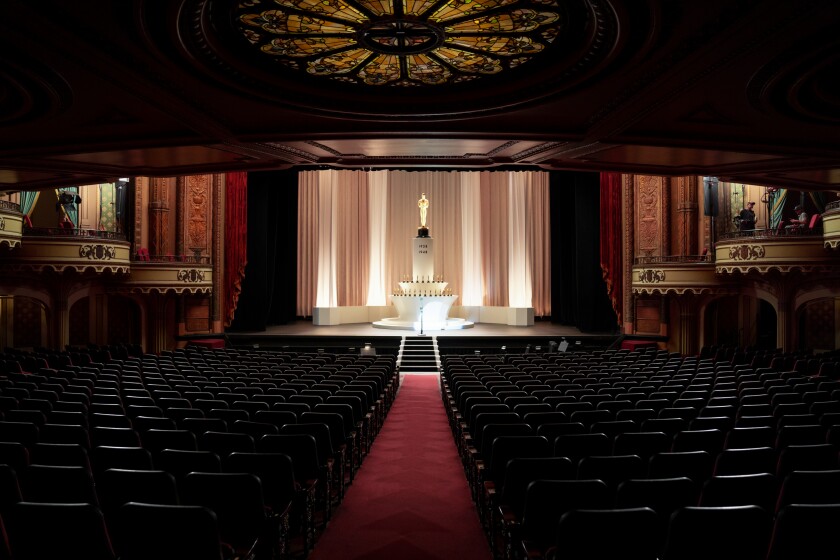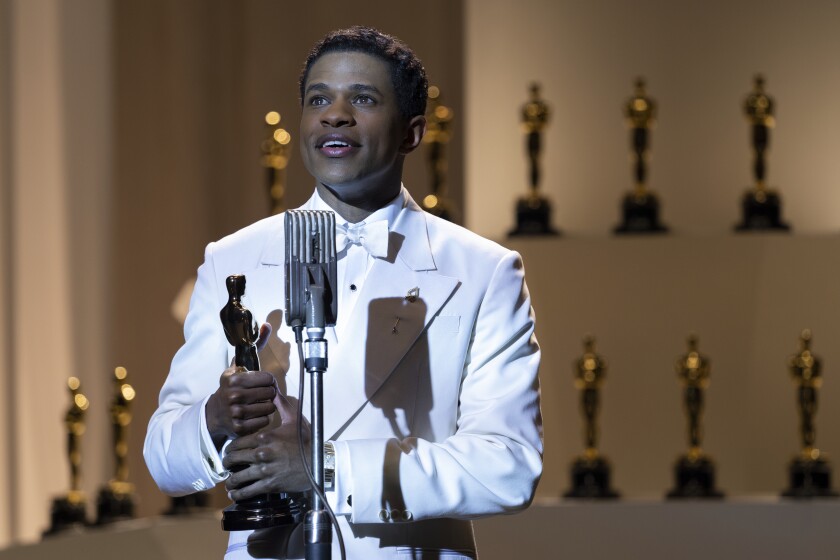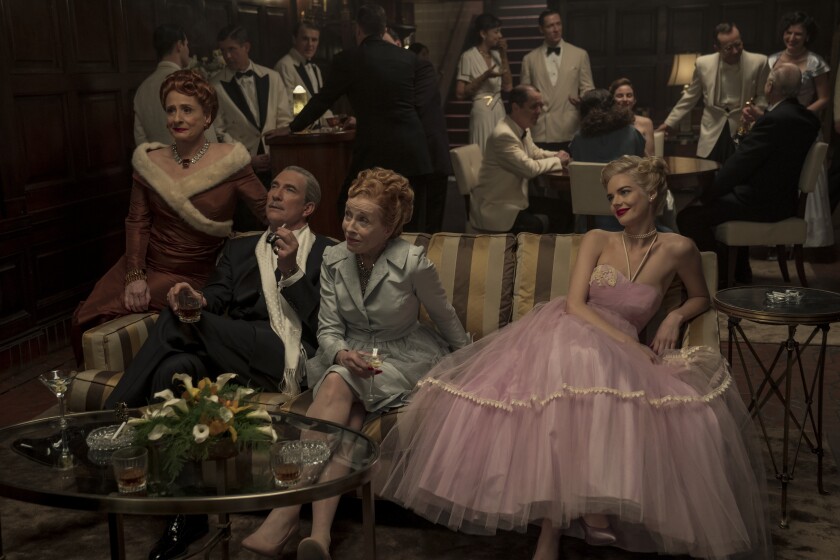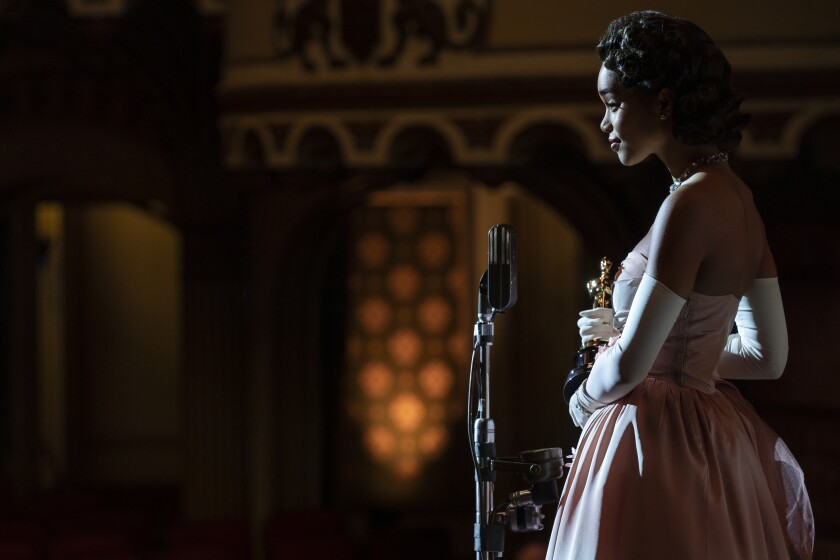The following story contains spoilers from the Netflix series “Hollywood.”
Soon after presenter and screen star Ernest Borgnine takes the stage at the 1948 Academy Awards, a few attendees depart to another corner of the venue for a brief intermission from the night’s nervous excitement. One is using the lull to fiddle with a crossword puzzle app on his cellphone.
“Oh, this is a good one... ’cause here we are at the Oscars,” David Corenswet says. “Eight letters. The clue is ‘snub.’ It ends in I-N-G.”
“Ignoring,” Samara Weaving replies, without hesitation. (She’s right.)
Advertisement
This is the time- and mind-warp taking place as new has a break from the old on the set of the finale of Netflix’s “Hollywood.”
From Ryan Murphy and Ian Brennan, the TV drama conceives a more progressive history for Hollywood’s Golden Age. The seven-episode season explores showbiz’s racist, sexist, homophobic past through a parallel universe in which its underdog cast of characters, who are working to get a feature film off the ground, get their fairy-tale ending — or close to it.

A production shot of the stage for the Oscars ceremony featured in Netflix’s “Hollywood.”
(Saeed Adyani / Netflix)
Advertisement
The series features portrayals of real-life icons like Anna May Wong (Michelle Krusiec), Rock Hudson (Jake Picking) and Hattie McDaniel (Queen Latifah) alongside fictional characters played by the likes of Corenswet, Weaving, Darren Criss, Laura Harrier, Jeremy Pope, Dylan McDermott, Holland Taylor, Patti LuPone and Jim Parsons.
In the drama’s season finale, titled “A Hollywood Ending,” the show’s central film, “Meg,” becomes a box office hit upon its theatrical release and, subsequently, receives multiple Academy Award nominations. A portion of the episode follows the characters as they attend the 20th Academy Awards and ultimately change the course of Hollywood history with some big wins for its marginalized characters.
“I was interested in doing a piece specifically on buried Hollywood,” says Murphy, whose grandmother kept him occupied as a child with books on old Hollywood. “The darker, more upsetting social-injustice aspects of the town that you really can’t believe. I grew up reading about Anna May Wong and Hattie McDaniel and Rock Hudson. And really how they should have had happy endings but didn’t. And I wanted to write about giving them a happy ending.”
It’s bustling inside downtown L.A.'s historic Orpheum Theater in mid-January as crew members dart around between shots and hundreds of background actors take their seats for the episode’s Oscars ceremony, the culmination of the drama’s revisionist history fantasy.
Advertisement
“The whole concept of the show is incredible to see and be a part of,” says Pope, who plays screenwriter Archie Coleman, who is black and gay. “It’s nice to see these outcasts of the time have their moment and for the audience to question the what-if — had things played out similarly then, how different things could look now.”
Surviving newsreel footage of the 20th Academy Awards in 1948 including Celeste Holm accepting Best Supporting Actress for “Gentleman’s Agreement,” Ronald Colman accepting Best Actor for “A Double Life,” Edmund Gwenn accepting Best Supporting Actor for “Miracle on 34th Street,” Francis Lyon and Robert Parrish accepting for Film Editing for “Body and Soul,” and Loretta Young accepting Best Actress for “The Farmer’s Daughter.”
It’s not the first time Murphy, who went to the 1989 Oscars ceremony as a reporter, has featured the event in his work. His FX period drama “Feud: Bette and Joan,” another love letter to old Hollywood, re-created the spectacle of the 1963 Academy Awards. In fact, the Oscars get the “Hollywood” treatment twice in “Hollywood.” But it’s the finale’s 1948 ceremony that plays a major role.
The actual Academy Awards ceremony in 1948, which was broadcast over the radio, was held at the Shrine Auditorium. Securing the location for the episode proved difficult because filming landed on the same week as the SAG Awards. But the essence of the Shrine can still be felt: The venue was used for exterior shots of the arrivals/red-carpet sequence, which were filmed the following week.
Advertisement
To re-create the night, the show’s production designer, Matthew Ferguson, relied on newspaper clippings, books and information culled online about the ceremony because the Academy doesn’t typically cooperate with sharing its materials.
“It was difficult, but not as difficult as you think,” Ferguson says.
While the design of the Academy Awards in the modern era is often ornate and intricate — the 2020 stage was decked out with more than 40,000 Swarovski crystals — the ceremony of 1948 had a more streamlined look: cream-colored fabric draped around four white columns and, at the center, an Oscar statue resting on an off-white tiered base whose silhouette resembles a chocolate fountain. (Fake statuettes lining the base of the two tiers had to be destroyed within five hours of filming, at the Academy’s request.) The prop department even replicated the ceremony’s program, which lists the order of awards and nominees.
“Anytime you do the Academy Awards, if you do it in a cheap way it feels terrible,” Murphy says. “So we kind of have an obligation to blow it out.”
Advertisement
The Orpheum had its lighting rigs and speakers removed from the venue to rid the space of any modern elements.

Jeremy Pope as Archie Coleman in a scene from the season finale of Netflix’s “Hollywood.”
(Netflix)
“Hollywood’s” take on the ceremony features many of the year’s actual nominees and presenters, such as Borgnine and Vivien Leigh. But instead of Loretta Young winning lead actress for her performance in “The Farmer’s Daughter,” it’s Camille Washington (Harrier), who had nearly been prevented from sitting in the theater for the ceremony because of her skin color. And instead of Sidney Sheldon winning for screenwriting for “The Bachelor and the Bobby-Soxer,” it’s Coleman, proudly kissing Hudson, his boyfriend, before taking the stage.
Advertisement
“We had a lot of repetition because in a situation like that, we’re getting it from every angle,” Parsons says. “All I will say is that that we got punch-drunk loopy by the end of the day. They were doing like a six-shot of six different people with us in that front row watching one speech that was happening. And I heard it so many times. ... I was laughing so hard I was crying. I finally had to look right in the lens and mouth, ‘I’m sorry,’ because I don’t know that I’ve ruined anybody else’s shot, but mine is trash.”
About 160 background actors, each dressed in period-appropriate attire, are crammed into the first dozen-plus rows near the front of the stage. (To fill in the surrounding empty seats, more were tiled into the frame in postproduction.)

Patti LuPone, left, Dylan McDermott, Holland Taylor and Samara Weaving in the season finale of Netflix’s “Hollywood.”
(Netlfix)
The color palette of the wardrobe also was very specific. After getting a sense of the styles and designers that were worn for the ceremony, the show’s costume designer, Sarah Evelyn, had to mold it to fit Murphy’s vision of the young cast’s dreamlike glow: the women in soft sherbet colors, the men in cream jackets.
Advertisement
For director Jessica Yu, the time at the Orpheum was frenetic. In addition to capturing the main ceremony upstairs, the crew was shooting downstairs for the green-room scenes, which feature Taylor, LuPone and McDermott’s characters listening to the ceremony over the radio.
“It was seven cameras going,” Yu says. “I was literally running up and down the stairs. And in a weird way, all the chaos felt like we were shooting the Oscars.”

Laura Harrier as Camille in a scene from Netflix’s “Hollywood.”
(Netflix)
It’s the episode’s acceptance speeches, though, that distinguish each character’s experience of taking home an Oscar.
Advertisement
Wong talks of the significance of winning the award as an actress of Chinese descent for a role that wasn’t a caricature. Coleman expresses his love for his boyfriend and signals that his win is proof to everyone who’s been othered that their stories are important. In her tearful acceptance speech, Washington points out what the moment means for all young girls.
“I think the thing that we were trying to get into speeches was they were shocked that they won,” Murphy says. “They were not entitled to anything. And when you don’t think you’re entitled, I think you’re speaking in a much more raw, emotional way.”
It’s a bittersweet reality, Murphy says, to imagine where Hollywood would be today if gains in representation, and recognition of that representation, had been made sooner. He refers to what happened with Wong as an example. In 1937’s adaptation of Pearl S. Buck’s “The Good Earth,” about a family of Chinese farmers, Wong was passed over for the female lead, O-lan. Instead, German actress Luise Rainer won the best actress Oscar in the role.
“Through the lens of today’s political correctness,” Murphy says, “you literally cannot believe that a white woman played the greatest Chinese part of all time with her eyes Scotch-taped in yellowface, and yet that’s exactly what happened.”
"Hollywood" - Google News
May 05, 2020 at 07:25AM
https://ift.tt/2SBM6pS
'Hollywood' on Netflix: How they made the Oscars episode - Los Angeles Times
"Hollywood" - Google News
https://ift.tt/38iWBEK
Shoes Man Tutorial
Pos News Update
Meme Update
Korean Entertainment News
Japan News Update
Bagikan Berita Ini















0 Response to "'Hollywood' on Netflix: How they made the Oscars episode - Los Angeles Times"
Post a Comment